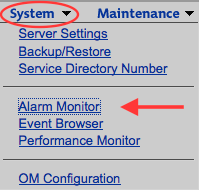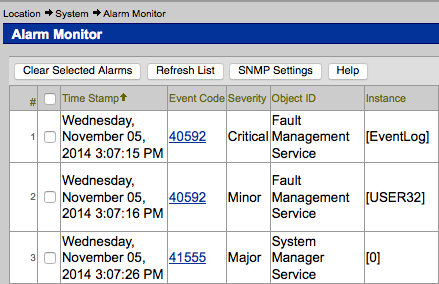CallPilot Alarm Monitor
If the CallPilot server faceplate display shows either CRI, MAJ, or MIN, an alarm (or event) has occurred.
This does not necessarily indicate a problem, it does indicate there are unread events in the Alarm Monitor log.

Review the CallPilot Alarm and Event logs to establish if action is required, clear the Alarm log to remove the alarm condition. The faceplate display will show OK with no alarms.
- Log into CallPilot Manager, click System ➤ Alarm Monitor.
- Review the alarms that occurred since the last time you checked.
- Click the Event Code for the first critical or major alarm. A description appears.
- Take any steps required to resolve any problems (if applicable).
- After you address and check each event, clear the event(s) from the Alarm Monitor.

When all Alarm entries are cleared, and no Alarm condition exists, a 201/202i faceplate will display OK.
About alarms:
Alarms are warnings generated by events. Alarms communicate the same information as events. However, alarms are reported in the Alarm Monitor instead of the Event Browser, and are managed differently than events:
- Alarms appear in the Alarm Monitor only for Minor, Major, and Critical
events.
All events can be reported in the Event Browser. - The first time an event occurs, it generates an alarm that appears in the
Alarm Monitor.
If the event continues to occur, the time and date of the original alarm is updated. - Alarms can be cleared from the Alarm Monitor, but the event that generated the alarm not.
Each alarm in the Alarm Monitor has Help text that often provides a solution to the problem. If the solution is not apparent, use the Event Browser or the Maintenance page to further investigate the problem.
About events:
The Event Browser displays events that have been recorded in the server log. Each event identifies the time the event occurred, the object that generated the event, and the cause of the event.
Events are classified as Information, Minor, Major, or Critical. By default, the Event Browser displays only the latest 100 critical events.